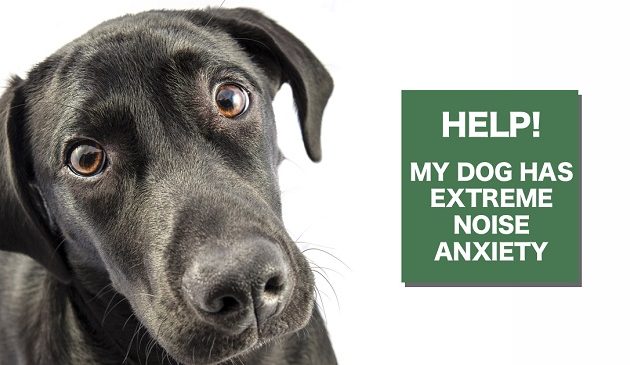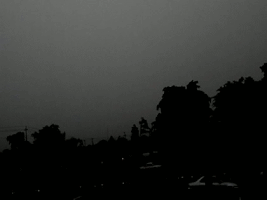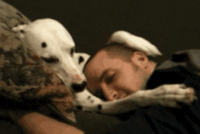
Summer is here, and with it, summertime thunderstorms as we have already seen and fireworks! Many dogs are terrified of thunderstorms and fireworks. A dog’s senses are very sensitive. They can feel, hear, smell and sense things much better than a human can and those loud booms, flashes of light and in the case of fireworks, the smell of gun powder, can be very intense for a dog. Do your pets start trembling the moment they hear the low rumbling of thunder in the distance?
 I’ve seen dogs who will hide under beds or even in bathtubs trying to escape from the “attack” of thunder and lightning. Some pets will go into a total panic attack trying to run away from the terrifying noise of fireworks and thunder, even to the point of hurting themselves. Dogs and cats can sense a storm’s approach by the rapidly falling barometric pressure, and so can begin to show signs of anxiety even before the storm can be heard. While it is not healthy for a dog to walk around in fear, I can certainly understand where the fear begins. It is how we humans handle their fear that makes the difference. A dog can get over fear issues, but it often takes time and the success depends upon the humans around the dog. The key is to understand the difference in how a human thinks vs. how the dog thinks.
I’ve seen dogs who will hide under beds or even in bathtubs trying to escape from the “attack” of thunder and lightning. Some pets will go into a total panic attack trying to run away from the terrifying noise of fireworks and thunder, even to the point of hurting themselves. Dogs and cats can sense a storm’s approach by the rapidly falling barometric pressure, and so can begin to show signs of anxiety even before the storm can be heard. While it is not healthy for a dog to walk around in fear, I can certainly understand where the fear begins. It is how we humans handle their fear that makes the difference. A dog can get over fear issues, but it often takes time and the success depends upon the humans around the dog. The key is to understand the difference in how a human thinks vs. how the dog thinks.
The dog is afraid because at some point a storm or firework scared it and at the time it did not get over the event for one reason or another. Often this is because of the way the humans around it reacted to its fear. When a dog is afraid it needs a being stronger than itself to help it feel secure and know there is nothing to be afraid of. People usually unknowingly make the mistake of petting and comforting the dog while it is afraid. That psychology works on a human but what most people do not understand is a dog thinks very differently than a human. When a dog is afraid of something and it is given affection while it is afraid, the dog interprets that as the person saying “good dog for being afraid,” which intensifies the dog’s fear. What the dog needs is someone to show it that they are strong enough to handle what is going on so the dog can feed from them.
 Dogs can sense how a human is feeling, therefore if you are afraid, upset, and nervous or feeling sorry, the dog knows it. Without a strong being around the dog to feed from, the dog can become even more afraid. Keep in mind that the age of the dog does not affect their ability to adapt and change; another difference between a human and a dog. Dogs live in the moment. Walking a dog helps it snap out of its fear. I do not recommend taking a dog out for a walk in a storm, but if you have a treadmill and are able to teach it to walk on it, you can get its mind moving forward by walking it while it is afraid. Taking a dog for an extra-long walk beforehand greatly helps and is sometimes possible if you have ample warning that a storm is coming or fireworks will be set off. When a dog is tired it has less energy to put into its fear and it can relax much easier. A lot of people try using a Thundershirt during storms. The shirt fits tightly around the dog and the idea is to slow the dog’s breathing, helping it calm down. When used correctly this sometimes works; if you put it on the dog while it is calm and the humans around it are calm. If you put the shirt on it while it is already afraid it will associate the shirt with the fear and it will have the opposite effect. When and how you introduce the shirt makes a big difference.
Dogs can sense how a human is feeling, therefore if you are afraid, upset, and nervous or feeling sorry, the dog knows it. Without a strong being around the dog to feed from, the dog can become even more afraid. Keep in mind that the age of the dog does not affect their ability to adapt and change; another difference between a human and a dog. Dogs live in the moment. Walking a dog helps it snap out of its fear. I do not recommend taking a dog out for a walk in a storm, but if you have a treadmill and are able to teach it to walk on it, you can get its mind moving forward by walking it while it is afraid. Taking a dog for an extra-long walk beforehand greatly helps and is sometimes possible if you have ample warning that a storm is coming or fireworks will be set off. When a dog is tired it has less energy to put into its fear and it can relax much easier. A lot of people try using a Thundershirt during storms. The shirt fits tightly around the dog and the idea is to slow the dog’s breathing, helping it calm down. When used correctly this sometimes works; if you put it on the dog while it is calm and the humans around it are calm. If you put the shirt on it while it is already afraid it will associate the shirt with the fear and it will have the opposite effect. When and how you introduce the shirt makes a big difference.
 To help your pet become accustomed to thunder and other loud noises, you can try some desensitizing behavior modification. This technique involves playing a recording of thunder at very low levels. It may be difficult, but refrain from soothing or petting your dog during this time. This often only encourages the fearful behavior, confirming that there is something to be afraid of. Additionally, if you are nervous, your pet may pick up on that. Instead, offer distractions – give a command, play a game, offer task-oriented distractions. Rewards or praise can be given for these activities and immediately after the task is completed so the dog makes the connection. Gradually increase the volume slowly over time, as your pet is able to handle the sounds without getting stressed. If your pet is not progressing, have patience, lower the volume and keep the sessions short and positive. Scolding a frightened animal is not effective will only intensify the fears. Many stores carry “relaxation” types of music, and I have seen several rain/thunderstorm CDs available. It is important to remember that this technique requires time and patience for it to be effective. Start slow, and do short sessions only at first. Fireworks can be fun for humans, but dogs don’t have the same reaction.
To help your pet become accustomed to thunder and other loud noises, you can try some desensitizing behavior modification. This technique involves playing a recording of thunder at very low levels. It may be difficult, but refrain from soothing or petting your dog during this time. This often only encourages the fearful behavior, confirming that there is something to be afraid of. Additionally, if you are nervous, your pet may pick up on that. Instead, offer distractions – give a command, play a game, offer task-oriented distractions. Rewards or praise can be given for these activities and immediately after the task is completed so the dog makes the connection. Gradually increase the volume slowly over time, as your pet is able to handle the sounds without getting stressed. If your pet is not progressing, have patience, lower the volume and keep the sessions short and positive. Scolding a frightened animal is not effective will only intensify the fears. Many stores carry “relaxation” types of music, and I have seen several rain/thunderstorm CDs available. It is important to remember that this technique requires time and patience for it to be effective. Start slow, and do short sessions only at first. Fireworks can be fun for humans, but dogs don’t have the same reaction.
The Humane Society that July is the busiest time of the year for them, as more dogs are found wandering loose on July 4th than any other day of the year in the U.S. So, when fireworks are scheduled to be fired off, make sure your dog gets plenty of exercise earlier in the day. Keep your dogs inside during fireworks, preferably with human companionship. If it’s hot, air conditioning will help. Bringing your dogs to a fireworks display is never a good idea. Provide a safe place inside for your dogs to retreat. When scared of sounds they can’t orient, dogs often prefer small enclosed areas. (I once heard of a dog who climbed in the bathtub during windstorms.) If your dog is comfortable in a crate, that is a good option. If possible, keep the windows and curtains closed. Covering the crate or lowering the blinds can also be helpful. Removing visual stimulation can also help calm dogs. Make sure all your dogs are wearing ID tags with a properly fitting collar. Dogs have been known to become Houdini around the 4th of July. Your dog’s phobia about fireworks and thunderstorms won’t get better on its own. Help him learn that “it’s just noise” and is nothing for him to worry about. When he learns to relax and remain calm, you can relax and not worry about your dog during future storms.
the year for them, as more dogs are found wandering loose on July 4th than any other day of the year in the U.S. So, when fireworks are scheduled to be fired off, make sure your dog gets plenty of exercise earlier in the day. Keep your dogs inside during fireworks, preferably with human companionship. If it’s hot, air conditioning will help. Bringing your dogs to a fireworks display is never a good idea. Provide a safe place inside for your dogs to retreat. When scared of sounds they can’t orient, dogs often prefer small enclosed areas. (I once heard of a dog who climbed in the bathtub during windstorms.) If your dog is comfortable in a crate, that is a good option. If possible, keep the windows and curtains closed. Covering the crate or lowering the blinds can also be helpful. Removing visual stimulation can also help calm dogs. Make sure all your dogs are wearing ID tags with a properly fitting collar. Dogs have been known to become Houdini around the 4th of July. Your dog’s phobia about fireworks and thunderstorms won’t get better on its own. Help him learn that “it’s just noise” and is nothing for him to worry about. When he learns to relax and remain calm, you can relax and not worry about your dog during future storms.






